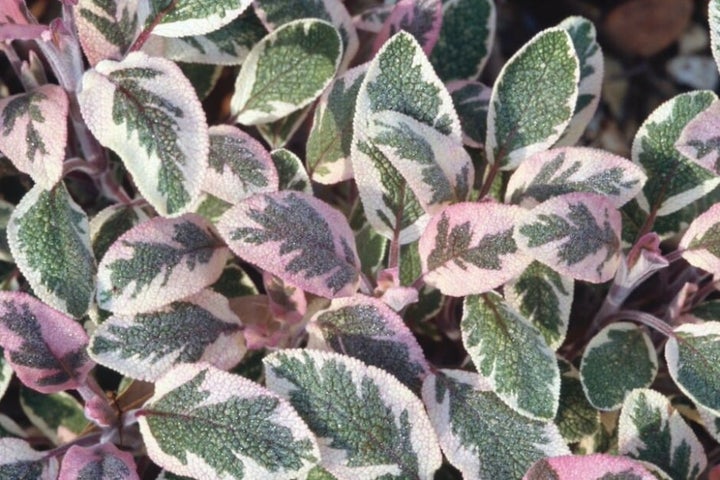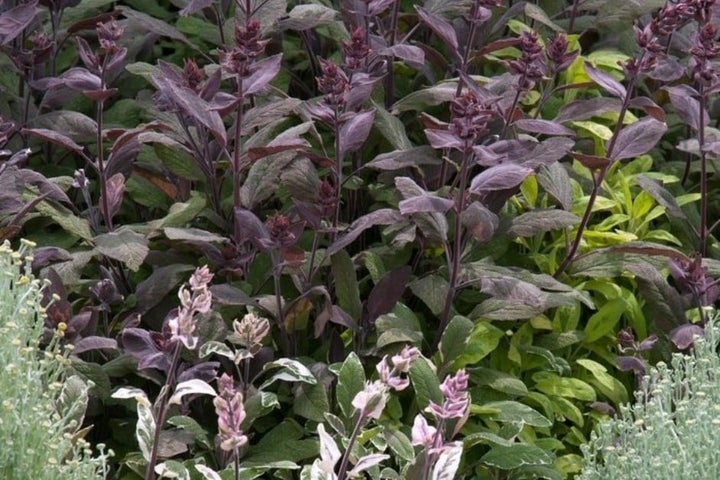Getting Started
This richly aromatic herb thrives in warm, sunny locations, in containers, herb gardens, veg plots and even flower borders. The leaves have a strong, earthy, slightly peppery flavour. They can be used to flavour many dishes and are an essential ingredient in classic sage and onion stuffing.

Sage (Salvia officinalis) is an attractive, drought-tolerant evergreen shrub with soft, grey-green leaves. Mature plants reach a height and spread of 30–90cm (1–3ft), depending on the variety. In summer, its attractive flowers in shades of blue and purple attract pollinating insects, particularly bees. Sage likes full sun in a sheltered spot, in free-draining soil or pots, and should live for several years with minimal maintenance.
Numerous plants have common names containing the word sage, including Russian sage (Salvia yangii), pineapple sage (Salvia elegans) and Turkish sage (Phlomis russeliana), but Salvia officinalis is the standard culinary sage. It's often referred to as common sage and there are many cultivated varieties of it (see Choosing below).
Jobs to do now
Harvest
Month by Month
Sow
Plant
Harvest
Choosing What To Grow

There are many varieties of sage to choose from. Some have attractive leaf colour, including dusky-purple ‘Purpurascens’, yellow-edged ‘Icterina’, and ‘Tricolor’ with , pink-tinged leaves. Leaf size can differ too – ‘Maxima’ has particularly large leaves. If you have limited planting space, there are some compact varieties, such as ‘Kew Gold’. White-flowered varieties are also available, such as ‘Albiflora’.
Look for varieties with an RHS Award of Garden Merit (AGM), which shows they performed particularly well in trials, and see our Recommended varieties below. You can view a wide range of herbs, including sage, in the RHS gardens, so do visit them for inspiration and growing tips.
What & where to buy
Sage is widely available from garden centres and online plant retailers, usually as young plants in spring and early summer. Larger plants in 2 or 3 litre pots are sold all year round. Specialist herb nurseries generally offer the widest selection of varieties. You can also buy packeted seeds of common sage from garden centres and online seed companies.
Recommended Varieties

'Purpurascens' AGM
Purple-grey foliage and mauve-blue flowers. An attractive plant with good flavour.

'Icterina' AGM
Bright yellow and green variegated leaves are well-flavoured. Pale purplish-blue flowers.

Sowing
Common sage can be grown from seed, but plants will take at least a year to grow large enough to reach harvesting size. It’s much quicker and easier to start with bought plants or cuttings. However, if you do wish to grow from seed, sow them indoors in spring. Sow into small pots or modular trays of moist peat-free and cover with a thin layer of fine . Place in a or cover with a polythene bag on a warm windowsill. Seeds should take about two weeks to germinate. Pot on the into larger or pots as they grow and keep them somewhere warm and bright.
Planting

Container-grown sage is available to buy all year round and can potentially be planted at any time, but the best time to plant sage is in spring, once the soil is starting to warm up. Indoor-grown plants should be at least 10cm (4in) tall and acclimatised to outdoor conditions by hardening off before you plant them outside.
Planting in the ground – choose a location in full sun with free-draining soil that never gets . If your soil is poorly drained, plant in a raised bed or a container to provide better drainage. Avoid planting too deep – ensure the top of the root system is only lightly covered with soil. Allow at least 30cm (12in) from neighbouring plants
Planting in a container – choose one that’s at least 30cm (12in) wide and deep, and make sure there are plenty of drainage holes in the base. Use a peat-free and mix in some horticultural grit (up to 25 per cent by volume) to improve drainage. Position the container in a warm, sunny spot, sheltered from strong winds.
Plant Care
Sage is easy to grow and needs little maintenance once established in a sunny position with free-draining soil. Regular harvesting of young leaves encourages bushy new growth.
Watering
Waternewly planted sage during dry spells in the first year after planting. Sage is drought tolerant once established and shouldn’t need additional watering when growing in the ground. In containers, the can dry out quickly, so check regularly over the summer – aim to keep the compost slightly moist but not saturated.
In winter, excess rain can cause the roots to rot, so move plants in containers to a sheltered spot, such as in the rain-shadow of a wall.
Feeding
Sage growing in the ground doesn’t need feeding and should thrive even in poor soil. However, plants that have been growing in the same container for more than one year will benefit from a sprinkling of general purpose granular feed in late spring or early summer.
Propagating

If you already have a sage, there are a few easy ways to propagate it. The methods below are forms of vegetative propagation, meaning the new plants will be the same as the parent plant. This is especially useful when varieties don't come true from seed.
- Softwood cuttings taken from new growth in late spring or early summer
- Layer plants in spring or autumn by pegging low stems into the soil to root. This often happens naturally, so check for rooted stems around the edge of your plant and pot them up
Sage plants tend to get rather woody and straggly after six or seven years, so it’s a good idea to propagate new plants regularly as replacements – that way you’ll always have attractive and productive sage.
Pruning And Training
Lightly prune established sage plants every year in mid- to late-spring to keep them compact and promote bushy growth of fresh new leaves. If left unpruned, older plants can become straggly and sprawling, with a bare centre. Pruning back hard into bare wood is risky, as older stems may not reshoot. It's usually best to replace old plants – fortunately, it’s easy to produce new plants (see Propagating above). Trim back the faded flower stems in late summer.
Harvesting

As sage is evergreen, the leaves can be picked at any time of year, but fresh growth in spring and summer has the best flavour. You can pick whole young shoots or individual leaves as required. To ensure the leaves remain in good condition over winter, you could protect them from the worst of the weather with biodegradable fleece or move plants in containers into a sheltered location.
The leaves are best used fresh, but you can also dry or freeze them. To dry sage, hang up some sprigs in a warm, dark, well-ventilated place. When fully dried, store the leaves in an air-tight jar. Freeze chopped sage leaves in an ice-cube tray, then simply add the cubes to your cooking whenever needed.
Problem Solving
Sage is generally a hardy and healthy plant. Just make sure it has a sunny location and free-draining soil or that doesn’t get . The leaves can be damaged by rosemary beetles, sage leafhoppers and capsid bugs, but these don’t generally cause severe problems so control isn’t necessary. Simply pick off any affected leaves if you wish. See Common problems below for more details.
Common Problems

Capsid bugs
Some capsid bugs can affect plants by giving the foliage a tattered and distorted appearance and causing flower buds to abort. Apple capsid can cause...

Powdery mildews
Powdery mildews are a group of related fungi which attack a wide range of plants, causing a white, dusty coating on leaves, stems and flowers.

Rosemary beetle
The rosemary beetle (Chrysolina americana) originates from southern Europe, and has become widespread in Britain since the mid-1990s. The larvae and a...




